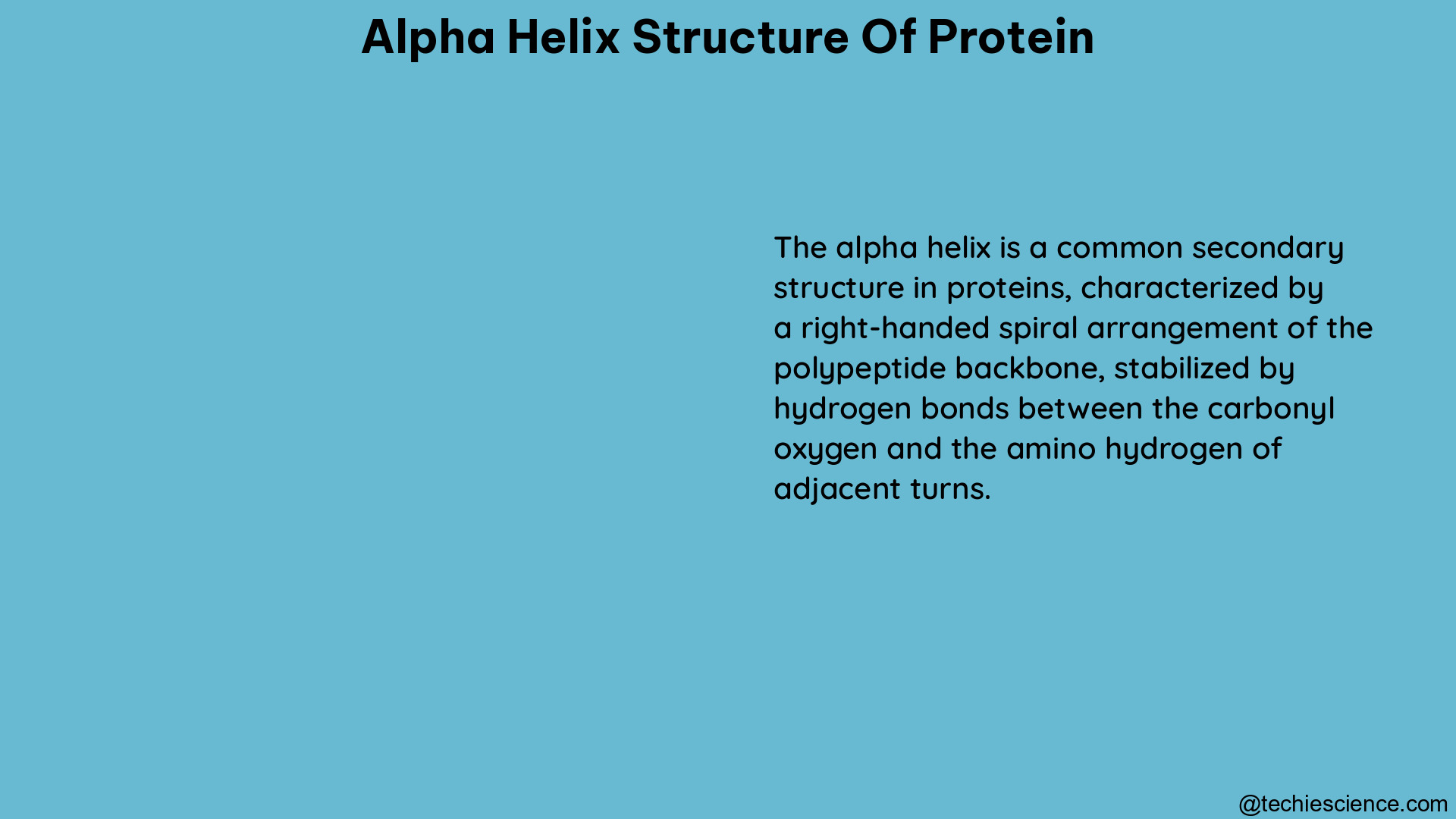The alpha helix is a ubiquitous secondary structure found in proteins, characterized by a distinctive rod-like shape and a repeating pattern of hydrogen bonds between the backbone atoms. Understanding the intricacies of this structural element is crucial for deciphering the complex folding and function of proteins.
Quantifying the Alpha Helix Structure
The structure of an alpha helix can be described by several key parameters, including:
-
Residues per Turn (ρ): This parameter represents the number of amino acid residues that make up one complete turn of the helix. The typical value for an alpha helix is around 3.6 residues per turn.
-
Angle between Backbone Carbonyls (ϑ): This angle, measured in degrees, describes the orientation of the backbone carbonyl groups relative to the direction of the helix. The average value for this angle is approximately 100 degrees.
These parameters are instrumental in determining the pitch and twist of the alpha helix, which are essential for its stability and functional properties.
Conformational Energy Landscape of the Alpha Helix

Researchers have delved into the conformational energy landscape of the alpha helix by analyzing data from the Protein Data Bank (PDB). Their findings reveal that the energy function of the alpha-helix backbone can be harmonically approximated on the (ρ, ϑ) space. This means that the energy of the helix can be described by a simple quadratic function of these two parameters, allowing for the prediction of its stability and flexibility.
The study also identified four conceptual simulations that can capture the observed trends of helical conformations obtained from the PDB. These simulations explore the effects of:
- Residue Bulkiness: The size and shape of the amino acid side chains can influence the packing and stability of the alpha helix.
- External Electric Field: The presence of an external electric field can alter the orientation and stability of the helix.
- Externally Applied Mechanical Forces: Mechanical forces, such as tension or compression, can deform the alpha helix and affect its structure.
These environmental factors and the amino acid sequence of the protein can collectively shape the structure and dynamics of the alpha helix.
Measuring Alpha Helix Structural Parameters
The key structural parameters of the alpha helix, such as the number of residues per turn (ρ) and the angle between backbone carbonyls (ϑ), can be directly measured from the three-dimensional structure of a protein. This can be accomplished using various computational tools and structural analysis techniques.
The stability and flexibility of the alpha helix can be quantified by measuring the energy required to deform it from its ideal conformation. This can be calculated using the harmonic approximation mentioned earlier, which provides a simple and efficient way to assess the energetic landscape of the helix.
Furthermore, the effects of residue bulkiness, external electric field, and externally applied mechanical forces can be quantified by measuring the changes in the alpha helix parameters under different conditions. This allows researchers to understand how the environment and amino acid sequence can influence the structure and dynamics of the helix.
Deformation Modes and Flexibility of Alpha Helices
A study of transmembrane alpha-helices revealed an interesting approach to quantifying the flexibility of these structural elements. Researchers used principal component analysis (PCA) to identify the dominant deformation modes, such as bending and twisting, that contribute to the overall flexibility of the helix.
By normalizing the eigenvalues of the deformation modes as a percentage of their total variance, the researchers were able to compare the relative importance of different deformation modes across various helix lengths and types. This provides valuable insights into the factors that govern the flexibility and stability of alpha helices in different protein environments.
Conclusion
The alpha helix is a fundamental structural element in proteins, and understanding its intricate details is crucial for unraveling the complex folding and function of these biomolecules. The parameters that define the alpha helix, such as the number of residues per turn and the angle between backbone carbonyls, can be directly measured and used to predict the stability and flexibility of the helix.
Furthermore, the conformational energy landscape of the alpha helix can be harmonically approximated, allowing researchers to explore the effects of environmental factors and amino acid sequence on the structure and dynamics of this important secondary structure. By delving into the deformation modes and flexibility of alpha helices, scientists can gain deeper insights into the adaptability and functional versatility of these ubiquitous protein building blocks.
This comprehensive guide on the alpha helix structure of proteins provides a solid foundation for understanding the intricate details of this essential structural element. With the wealth of data and analytical techniques available, researchers can continue to unravel the mysteries of protein folding and function, ultimately leading to advancements in fields ranging from structural biology to drug design.
References:
- Bevacqua, A., Bakshi, S., & Sazanov, L. A. (2021). Principal component analysis of alpha-helix deformations in transmembrane proteins. PLOS Computational Biology, 17(9), e1009038.
- Fiser, A., & Sippl, M. J. (2003). Flexibility of α-helices: results of a statistical analysis of database structures. Journal of Molecular Biology, 327(5), 979-990.
- Bahar, I., & Jernigan, R. L. (2016). A closer look into the α-helix basin. Scientific Reports, 6, 38341.
- Alpha helix. (n.d.). In Wikipedia. Retrieved July 9, 2024, from https://en.wikipedia.org/wiki/Alpha_helix
- Bahar, I., & Jernigan, R. L. (2016). A closer look into the α-helix basin. PLOS ONE, 11(12), e0168345.
Hi …I am Tulika Priyadarshini, I have completed my Master’s in Biotechnology. Writing gives me mental peace and satisfaction. Sharing the knowledge that I gain in the process is a cherry on the cake. My articles are related to Lifesciences, Biology and Biotechnology. Lets connect through LinkedIn-